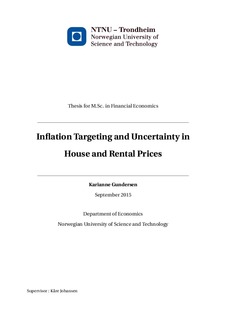| dc.description.abstract | In 2001 Norway officially implemented a flexible inflation targeting monetary policy. This
has coincided with escalated growth in house and rental prices. Studies have shown that,
after implementing a flexible inflation target, countries tend to experience two characteristic
trends compared to non-inflation targeting countries: house prices tend to increase at a
greater rate, and inflation is lower and less volatile. As an addition to this line of research,
this thesis investigates how flexible inflation targeting affects uncertainty, or volatility, in the
housing market. This study contributes empirical evidence on how implementing flexible
inflation targeting has affected volatility in house and rental prices in Norway, from 1979-
2015. Using both GARCH and EGARCH models, the results generally suggest that flexible
inflation targeting is associated with a decrease in the volatility of house and rental prices.
This conclusion is generally robust because it holds for most specifications for the conditional
mean and variance, and for both the market for owning and renting residential property
in Norway. | nb_NO |
